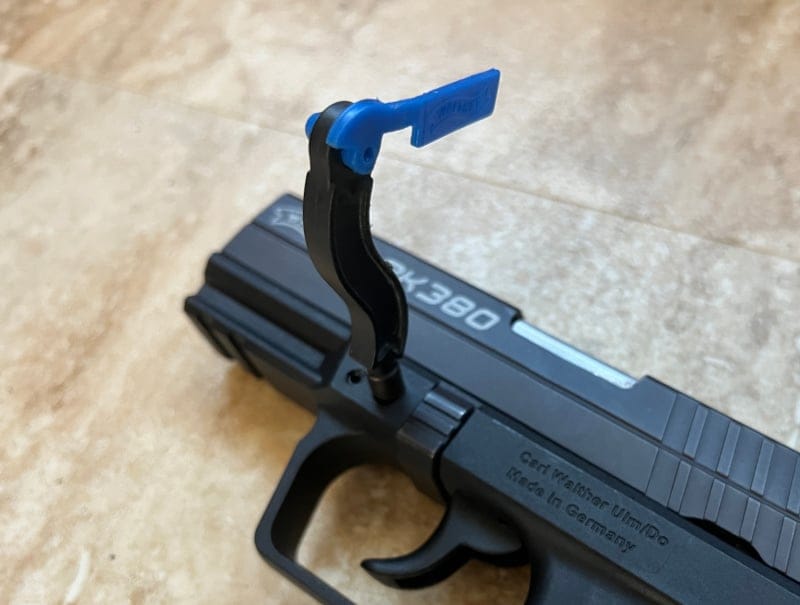When it comes to compact .380 ACP pistols, two of the most popular choices come from Walther: the PK380 and its successor, the PD380, a brand-new version that came out in late 2023. At first glance, these two concealed-carry handguns look nearly identical. However, Walther made some worthwhile upgrades to the PD380, making it a slightly better overall gun. Here’s a quick rundown of how these two Walthers compare.
What’s the Same?
The most obvious similarity between the PK380 and PD380 is their look and dimensions. When I first saw the newer gun, I thought someone had just customized an older one. That’s how similar they look at first glance. They have the same sleek, snag-free profile with gentle curves rather than sharp edges or protrusions. They share an overall length of just 6.5 inches and feature 3.66-inch barrels. Their widths are identical at 1.27 inches, which allows for comfortable inside-the-waistband carry for most people. Even their weights are comparable, with the PK380 weighing in at just 17.2 ounces and the very marginally heavier PD380 coming in at 17.5 ounces. From an external standpoint, these Walthers appear nearly indistinguishable. It’s not until you look more closely that the differences begin to jump out.

Another significant shared attribute between the PK380 and PD380 is their method of operation. Both feature blowback double-action/single-action ignitions that are easy to operate and maintain. They fire the mild-recoiling .380 ACP cartridge, making them comfortable to shoot. Their trigger pulls measure an identical 10 pounds in double-action and 6.5 pounds in single-action. While those may sound heavy, don’t let the numbers deter you. Somehow, Walther made the triggers super easy to pull. I have shot many Walthers, all of which had great triggers, perhaps the best factory triggers on the market.

Walther has long been known for amazing ergonomics, with these two guns being no exception. The PK380 and PD380 once again have nearly equal billing. They both use grip frames made from Walther’s proprietary Advanced Polymer Technology, a durable fiberglass-reinforced nylon that stands up well to daily concealed carry. The shaping and texturing on both models provide a secure and comfortable grasp. Both models utilize an ambidextrous thumb-activated magazine release as well.
One quirk about both of these guns is the lack of a slide stop. The slide locks open on an empty magazine, but you can’t manually release the slide with a button or lever. You have to either remove the magazine and then rack the slide or put in a full magazine and rack it. I assume Walther carried this over to the PD380 because it uses the same firing mechanism as its older brother, but it would be nice to have an external slide stop.
What’s Different?
That covers much of what makes the PK380 and PD380 so alike. Fortunately, the R&D team at Walther decided to make some worthwhile improvements in the PD380 to address common complaints about the PK380. Let’s look at the key upgrades they baked into this next-generation .380 ACP offering.
The most strikingly obvious difference between the two on the outside is the cocker serrations. The older PK380 has a smooth front and fairly shallow rear serrations that work but don’t stand out. The new PD380 carries over the aggressive “SuperTerrain Slide Serrations,” as Walther calls them, from the rest of the PDP line on both the front and back of the slide. These massive, chunky notches provide great grip when racking the slide.

One issue that has affected a decent percentage of PK380 handguns is slide velocity. Some users reported the slides didn’t always have enough rearward velocity to cycle reliably. This reportedly failed to go into battery. In my years of owning a PK380, I never had this happen to me. For those who did, Walther re-engineered the operating springs in the PD380 to ensure reliable function without increasing perceived felt recoil or making the slides overly difficult to manipulate by hand.
Speaking of springs, my biggest pet peeve about the older PK380 is the non-captured recoil spring. Many a time I have chased it across the basement floor during field stripping. And it’s a real pain to reassemble once I track it down. Thankfully, Walther changed this in the PD380, which has a captured recoil spring like other civilized firearms. They also eliminated the special key required to disassemble the gun. Instead, they replaced it with a more conventional takedown system that doesn’t require any special accessories that you never have with you when you need them.

One last difference worthy of mention is the PD380’s 9+1 capacity over the PK380’s 8+1 capacity. Finding ways to boost payload within nearly identical dimensions required Walther’s cleverness to make this happen. Having one extra round on tap makes for a nice upgrade, especially considering how quickly ammunition disappears when you need it most.
Parting Shots
While the Walther PK380 and PD380 share essentially identical size, weight, aesthetics, and many ergonomic commonalities, the PD380 emerges as the superior overall package. Walther eliminated some functional shortcomings of the PK380 and added some worthwhile feature enhancements without negatively impacting size, weight, or concealability. That’s an impressive feat by any engineering team. Cost puts both pistols in the same ballpark, The PD380 delivers more everyday utility than today’s concealed carriers demand.


